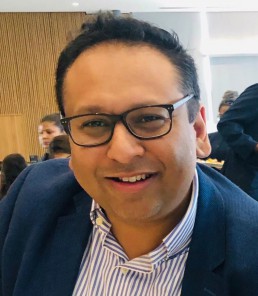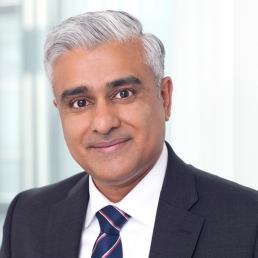Precision medicine - using data to prevent heart disease and stroke
Curzon Healthcare Lead Chetan Trivedi in conversation with Dr Rameen Shakur MD PhD (Cantab), Massachusetts Institute of Technology, Boston. We explore precision medicine, the importance of a patient centric approach to data and how medical technology is improving healthcare accessibility.
Rameen is the founder of Cambridge Heartwear and the Jansen Fellow for Cardiology and precision medicine at Massachusetts Institute of Technology (MIT). This interview was not sponsored. All views are Dr Rameen Shakur’s and not that of MIT.
Watch a highlight of our conversation below

Precision medicine and technology
Precision medicine refers to the tailoring of medical treatment to the individual characteristics of each patient.
Precision medicine does not mean the creation of drugs or medical devices that are unique to a patient, but rather the ability to sub-classify individuals into populations that differ in their susceptibility to a particular disease. And for that to occur, Rameen argues we need “not just the therapeutic arm, the diagnostic arm, but also the analytical arm to all intermingle in one.”
Rameen is the founder of Cambridge Heartwear, a medical technology and AI device manufacturer. Through novel engineering, Rameen and his colleagues at University of Cambridge fused diagnostics, and real-time delivery of data and analytics. Cambridge Heartwear aims to reduce the impact of strokes by detecting irregular heart rhythms in real-time through a pairing monitoring device and artificial intelligence algorithms. This real-time wearable ECG (electrocardiogram) device has cut the diagnosis and treatment process down from three weeks to days. Rameen explains it is also a means to measure our physiology in more granularity.
Part of Cambridge Heartwear’s goal is more integrated healthcare across primary, secondary and tertiary care. Rameen explains “once you deal with that whole process of how to manage a system to amalgamate all of those together, then you make a real inroad into what we want to call precision medicine.”
Similar to many technology companies, such as HP and Apple, Rameen built the first prototype in a shed in his back garden.

Patient centric design
What makes Cambridge Heartwear disruptive is the focus on the patient. Throughout the design process, Rameen is “very patient centric”.
This carries through to the availability and ownership of data. “It’s patient centric because if we want to get to a view of precision medicine, you have to give access to people for that data. The point is it is their data. It is their own right to actually have that data, access that data and do as they please with that data.” From the patient perspective it is a means for them to obtain specific data related to the cardiovascular system for the first time, namely the whole electricity of the heart when they’re moving around. Consequently, access to this data enables people to have an informed conversation with physicians on treatment modalities.
This focus on the patient not only applies to data but the design of the wearable itself “We wanted a wearable that would be ergonomic”. The design encompassed:
- Real-time data and analytics transmission from patient to physician across the world
- Patient experience – “we wanted a system where you can go about your daily business”
Historically many medical technology companies have adopted a male-centric approach to data and design. Rameen was mindful of gender bias in his medical technology design, stating
“the whole design was done for the anatomical differences between males and females.”
Accessibility for all is at the heart of what Rameen’s trying to achieve. He believes that coronavirus has affected healthcare by firstly highlighting the health inequalities that exist in society and secondly adopting technology to break down those barriers. “who has access has power is no longer the statement that we want to hear”. The COVID-19 pandemic has also highlighted the important role of technology to deliver information from patients’ homes to hospitals and physicians.

The future of precision medicine
We ask Dr Rameen what precision medicine could look like in the next 30 years.
“Precision medicine I hope will garner a lot of technology, innovation and discovery. In our lab, for example, we are teasing out for the first time methodologies for risk stratification for patients who may have had the genetic test.
We are getting more and more nuanced in the way we collect data. Previously, for example when we talked about disease associations, we referred to a particular subpopulation, a particular racial population… For a complete picture, one needs to know and have a whole profile of different technologies that are applicable across the board, across society. I believe what we need to do is to bring that back to society and say, let’s talk about it in the context of the population of our global population.”
I believe we will likely see more integration of digital technology with the biotech fields… I hope to see more of this sort of collaboration where novel engineering comes head to head with medical technology processes, whereby the actual information is now being stored in biological systems, having a discourse with physicians at a much more accessible point. And I think this concept which has started to happen
“It’s a very exciting time within the next five to 10 years, we’re seeing a lots of big changes”.
The concepts of portability and real time data are “something that we are very proud to work on and something that’s also of interest to us as we move to our next phase of humanity into space.” Indeed, the emergence of space travel tourism launches an opportunity to observe medical data and physiology outside of the earth’s atmosphere.
But one thing’s for certain, the aim of medical technology is not to replace humans.
“I think one of the key points about technology is we have to get away from just being a tech company. You are a human company, which is dealing with humans and for the survival of patients, we need to have all in our armoury. So I make no apology to say that we would never want to replace the physician, but rather to make that whole process a lot easier and less journey as for all involved.”
An important time for innovation in the UK
Rameen is proud of the work that UK engineers and manufacturers are doing right now. He believes that as a country
“we are very strong in artificial intelligence. We may not have previously been very vocal about that, but the proof is in the pudding. And I’m glad to say a lot of people are having the puddings!”
We can help you to improve patient outcomes with digital strategy, transformation and patient experience.
In conversation with

Dr Rameen Shakur MD PhD (Cantab), Massachusetts Institute of Technology, Founder of Cambridge Heartwear
Contact us for more information or submit a request for proposal to our healthcare consulting team
Extracting value from data analytics in manufacturing
In an article published in Raconteur’s “Future of Manufacturing’, John Mason discusses how manufacturing firms have turned to data analytics and artificial intelligence and asks how many are failing to reap the rewards. What is needed is a sharper business focus to achieve expected returns.
Aside from the high-tech and leading corporates, adoption of digital technologies in the manufacturing sector remains subdued, a consequence perhaps of not seeing widespread evidence of the tangible benefits. Achieving expected returns on investment from advanced analytics and AI is less a question of technology and more a business challenge.
Success stories among early adopters are well publicised and demonstrate the advantages to be gained when the power of data from multiple sources is harnessed through expert hands and into business execution.
More precision in research and development reduces costs and increases success, product lead times can be compressed, sales and service are optimised for overall value, goods can become services, supply chain efficiencies are maximised, defects are reduced and production assets can operate at their potential.
For many though, there are “missing links” that are preventing the expected value being realised from the potential a wealth of data, analytical skills and technology are offering.
Clarity of business priorities is the starting point and that requires executive level direction. Technology has provided the toolkit, but how it should be used to best effect cannot be delegated to the IT function. The increasing presence of chief digital officers on executive teams is one trend bridging the gap between the business agenda and the role of technology.
“Generating business insight is a critical business capability that unlocks new value yet sometimes seems to be forgotten among the increasing volume of information and analysis,” explains John Mason.
Advanced analytics enable businesses to combine multiple datasets to highlight new information. The same cross-functional thinking is required in the application of this information.
For example, optimising asset performance will require co-ordinated action across production, engineering, maintenance and third-party equipment suppliers to achieve the potential performance uplift that connectivity and predictive analytics can offer. Most importantly, the business and IT functions need to work much more closely, and find a common language.
Risks associated with data security are often cited as a brake on adoption. Having a robust governance framework that defines who owns what information and how it should be used is essential.
50%
initiatives don't deliver their cost of capital
67%
companies reported human and technical capabilities as a bottleneck
Arguably the least considered aspect of a technology-led investment in data and analytics is the practicality of turning insights into measurable results. Success requires organisations to have the capabilities to act on and implement changes. The ability to test, learn, adapt and adopt is needed at all levels, and information needs to be made available to those who are going to use it in a way that is practical. Implementing minimum viable products and adopting “fast-fail” approaches that can quickly demonstrate impact are not widely established practices in many organisations.
Operating models and processes need to be capable of accommodating evolving knowledge, and the perceived threat that time-served, experienced staff may feel need to be overcome. “The expectation that the whole organisation will automatically see the benefits is likely to be unfulfilled. Involvement and ownership are key, as they are for any sustainable business change to work,” says Mr Mason.
When the links are forged for businesses to generate genuine commercial insight and swiftly translate it into action, the potential advantage of analytics will be fully realised.

This article originally featured in Raconteur, August 2018
About the author

John Mason
I lead our Manufacturing practice helping clients tackle complex business challenges to achieve a step-change in outcomes, whether it be re-shaping for growth, accelerating performance improvement, or leveraging the possibilities offered by digital and automation technologies in a time of rapid evolution.






